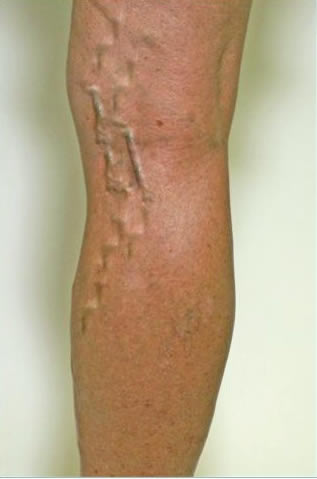Varicose veins are swollen, lumpy looking, dark blue or purple veins. They can happen anywhere in the body, but occur most often in the legs, because that is where the pressure of standing and walking impacts the body most.
They’re unsightly looking, but they can also be dangerous. Although some varicose veins are painless, others are debilitating painful. Left untreated, they can also lead to serious medical problems such as venous disease, ulcers and blood clots.
What are varicose veins?
Our veins use a system of small valves that open and close to pump blood in the right direction, towards the heart. Varicose veins develop when these tiny valves get damaged. If blood can no longer flow through effectively in the same direction, it can pool in the vein or even go backwards, causing the twisted, lumpy purple swelling that we know as varicose veins.
Causes of varicose veins
Varicose veins are a common problem, impacting 1 in 3 adults. They impact women 2 to 3 times more often than men, because the female hormone oestrogen has the effect of relaxing the vein walls, meaning they are more likely to leak. A number of factors are involved in the development of varicose veins. Some of the more common include:
- Genetic predisposition
- Hormonal issues
- Pregnancy
- Aging
- Inflammation or injury involving the veins
- Prior circulatory problems
Complications of varicose veins
Some varicose veins are merely unsightly. Others can lead to more than self-consciousness, causing pain and swelling in the legs, itching, restless legs and swollen ankles. Varicose veins can also cause medical issues such as venous disease and blood clots if they are not treated.
Venous disease
80% of venous disease is caused by varicose veins. When damage to valves in the vein causes blood to pool or flow backwards in the vein, it creates abnormally high pressure under the skin, which can lead to painful ulcers. Up to half a million UK residents are estimated to suffer from ulcers.
Blood clots
A varicose vein on the surface of the skin indicates that there are difficulties with blood circulation below the surface. When blood can’t flow smoothly, it is at risk of coagulating. This can cause dangerous blood clots.
Prevention and management
There are no 100% effective methods of preventing varicose veins, however there are many things you can do to manage the condition. Self-care techniques such as leg elevation, regular movement and supportive clothing can be very helpful.
Leg elevation
Elevating your legs relieves the pressure of standing and makes it easier for blood to flow to your heart.
Exercise and movement
Jobs like waitressing or working behind a counter can involve standing for long periods of time. The pressure this puts on your legs means it is more difficult for blood to flow around your body. Your veins need to work harder, increasing the risk of damage to the valves. Regular movement and exercise keeps your blood circulating smoothly.
Carrying excess weight is another factor in the development of varicose veins. Managing your weight through exercise will not only keep you looking good and feeling better, it will help varicose veins as well.
Foot and leg exercises can be especially helpful – here are a few to try out.
Support tights
Compression stockings are a good option for supporting your legs as well as preventing veins from swelling.
Article Submitted By Community Writer





